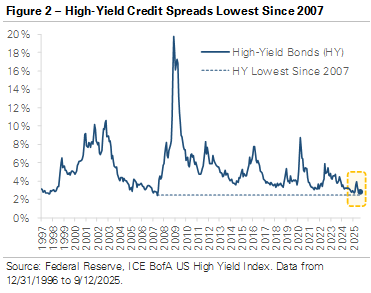
Chart of the Month | September 2025
Navigating Corporate Bond Trade-Offs: Attractive Income, Limited Cushion
Corporate credit spreads are at levels not seen in decades. Investment-grade credit spreads, which measure how much more a top-rated company pays to borrow compared to the U.S. government, have fallen to 0.77%, a level last seen in1998 (Figure 1). Historically, the spread is closer to 1.30%, a half percentage point higher. High-yield spreads are similar but not as extreme. The current high-yield spread is 2.79%, the tightest since 2007 and well below the median of 4.59% since 1996 (Figure 2). Today’s credit spreads stand out for how tight they are compared to history, with companies paying a significantly smaller risk premium to borrow.

Several factors explain why credit spreads are so tight. First, overall corporate bond yields remain high in absolute terms compared to the past decade. Investment-grade and high-yield bonds yield 4.80%and 7.03%, respectively, making them attractive even with tight credit spreads. Second, corporate fundamentals are healthy, with strong earnings growth, manageable debt loads, and high interest coverage ratios. In contrast, the market is concerned about the current trajectory and sustainability of government finances. In a reversal of roles, the government—not corporations—is paying a higher risk premium, with concerns over fiscal policy keeping Treasury yields elevated. Third, the market is more confident that the Federal Reserve will continue cutting interest rates into 2026. As a result, investors are moving to lock in today’s yields, anticipating that interest rates will decline in the coming year.

While spreads are low by historical standards, extreme valuations don’t always correct quickly and often need a catalyst to normalize. What could shift the balance of risk and change the market’s view on corporate credit risk? Two scenarios stand out. First, an economic slowdown or decline in profit margins could cause the market to demand a higher risk premium, leading credit spreads to widen. Second, if companies take advantage of their tight spreads and borrow more, it will increase the supply of corporate bonds. An increase in supply, whether to fund mergers, stock buybacks, or other initiatives, without a corresponding rise in investor demand could cause spreads to widen and bond prices to fall.
Today’s yields present a compelling opportunity for income-focused investors, but they also come with important trade-offs. Credit spreads are at multi-decade lows, and when spreads are this tight, there’s less room for error. For investors, that means understanding the risks, emphasizing quality, and maintaining diversified bond exposure, including Treasury, corporate, and municipal bonds. The market isn’t signaling danger, but it is not offering a margin of safety either. In this environment, it pays to be disciplined and keep a long-term perspective.
Views expressed are as of the date indicated, based on the information available at that time, and may change based on market or other conditions. Investment decisions should be based on an individual’s own goals, time horizon, and tolerance for risk. Investing involves risk, including risk of loss. Investment advisory services provided by Provident Financial Planning, LLC, a SEC-Registered Investment Advisor.
The information and opinions provided herein are provided as general market commentary only and are subject to change at any time without notice. This commentary may contain forward-looking statements that are subject to various risks and uncertainties. None of the events or outcomes mentioned here may come to pass, and actual results may differ materially from those expressed or implied in these statements. No mention of a particular security, index, or other instrument in this report constitutes a recommendation to buy, sell, or hold that or any other security, nor does it constitute an opinion on the suitability of any security or index. The report is strictly an informational publication and has been prepared without regard to the particular investments and circumstances of the recipient.
Past performance does not guarantee or indicate future results. Any index performance mentioned is for illustrative purposes only and does not reflect any management fees, transaction costs, or expenses. Indexes are unmanaged, and one cannot invest directly in an index. Index performance does not represent the actual performance that would be achieved by investing in a fund.
Subscribe to receive the latest blog posts to your inbox every week.
Guided by our values of faith, service, and transparency, we at Provident Financial Planning are ready to help you navigate your financial journey. Schedule a consultation with us and discover how we can create a personalized financial plan for you.
